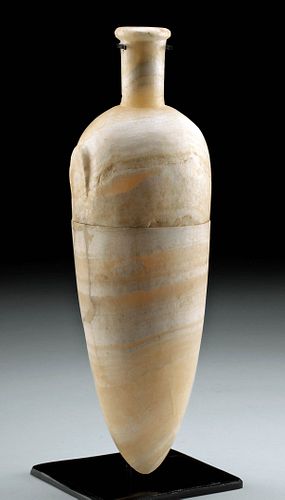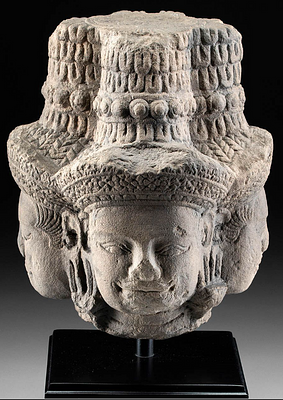Exhibited Egyptian New Kingdom Alabaster Flask
Lot 8
About Seller
Artemis Fine Arts
686 S Taylor Ave, Ste 106
Louisville, CO 80027
United States
Selling antiquities, ancient and ethnographic art online since 1993, Artemis Gallery specializes in Classical Antiquities (Egyptian, Greek, Roman, Near Eastern), Asian, Pre-Columbian, African / Tribal / Oceanographic art. Our extensive inventory includes pottery, stone, metal, wood, glass and textil...Read more
Categories
Estimate:
$10,000 - $15,000
Absentee vs Live bid
Two ways to bid:
- Leave a max absentee bid and the platform will bid on your behalf up to your maximum bid during the live auction.
- Bid live during the auction and your bids will be submitted real-time to the auctioneer.
Bid Increments
| Price | Bid Increment |
|---|---|
| $0 | $25 |
| $300 | $50 |
| $1,000 | $100 |
| $2,000 | $250 |
| $5,000 | $500 |
| $10,000 | $1,000 |
| $20,000 | $2,500 |
| $50,000 | $5,000 |
| $100,000 | $10,000 |
| $200,000 | $20,000 |
About Auction
By Artemis Fine Arts
Jun 29, 2023
Set Reminder
2023-06-29 10:00:00
2023-06-29 10:00:00
America/New_York
Bidsquare
Bidsquare : Exceptional Antiquities, Ethnographic and Fine Art
https://www.bidsquare.com/auctions/artemis-gallery/exceptional-antiquities-ethnographic-and-fine-art-13031
Artemis Fine Arts info@artemisgallery.com
Artemis Fine Arts info@artemisgallery.com
- Lot Description
Ancient Egypt, New Kingdom, 18th to 20th Dynasty, ca. 1550 to 1070 BCE. A slender flask of inverted piriform presentation that is hand-carved from attractive banded alabaster. The top and bottom halves likely originated as separate vessels and were attached in modern times, however the fit around the diameter as well as the overall size are quite impressive. The flask exhibits a narrow cone base that gradually widens to form the broad body and rounded shoulder, and a pair of raised handles protrude from the sides. Size: 2.5" W x 8" H (6.4 cm x 20.3 cm); 8.25" H (21 cm) on included custom stand.
Alabaster was quarried along the length of the Nile, from Giza to just south of Luxor, and the Egyptians made carved alabaster pieces famous throughout the ancient world. The piece was drilled into, and then special tools were used to expand the drilled-upon areas.
Exhibited in the Robert and Frances Fullerton Museum of Art (RAFFMA), California State University, San Bernardino from 1998 to 2023, reference number EL01.046.1998.
Provenance: Collection of Dr. W. Benson Harer, Los Angeles, California, USA; Exhibited in the Robert and Frances Fullerton Museum of Art (RAFFMA), California State University, San Bernardino from 1998 to 2023, reference number EL01.046.1998
All items legal to buy/sell under U.S. Statute covering cultural patrimony Code 2600, CHAPTER 14, and are guaranteed to be as described or your money back.
A Certificate of Authenticity will accompany all winning bids.
We ship worldwide and handle all shipping in-house for your convenience.
#178990Top and bottom half attached near midsection and are perhaps not of the same vessel but are from the same time period. Bottom half repaired from 4 pieces with some light infill and resurfacing along break lines. Upper half repaired in one area with light adhesive residue along break lines. Minor abrasions and some surface wear, otherwise in excellent condition. Great surface smoothness throughout.Condition
- Shipping Info
-
All shipping is handled in-house for your convenience. Your invoice from Artemis Gallery will include shipping calculation instructions. If in doubt, please inquire BEFORE bidding for estimated shipping costs for individual items.
-
- Buyer's Premium



 EUR
EUR CAD
CAD AUD
AUD GBP
GBP MXN
MXN HKD
HKD CNY
CNY MYR
MYR SEK
SEK SGD
SGD CHF
CHF THB
THB














